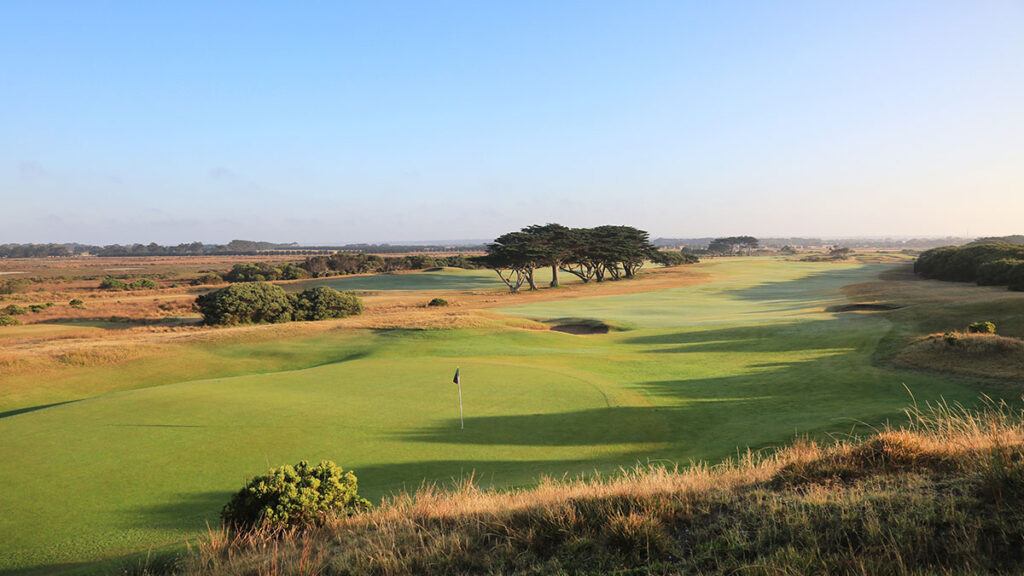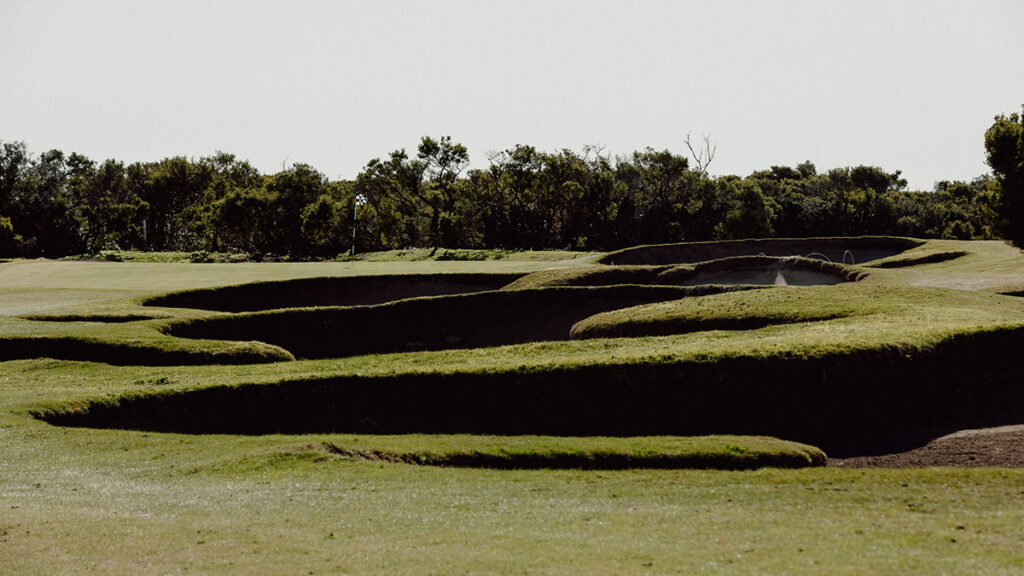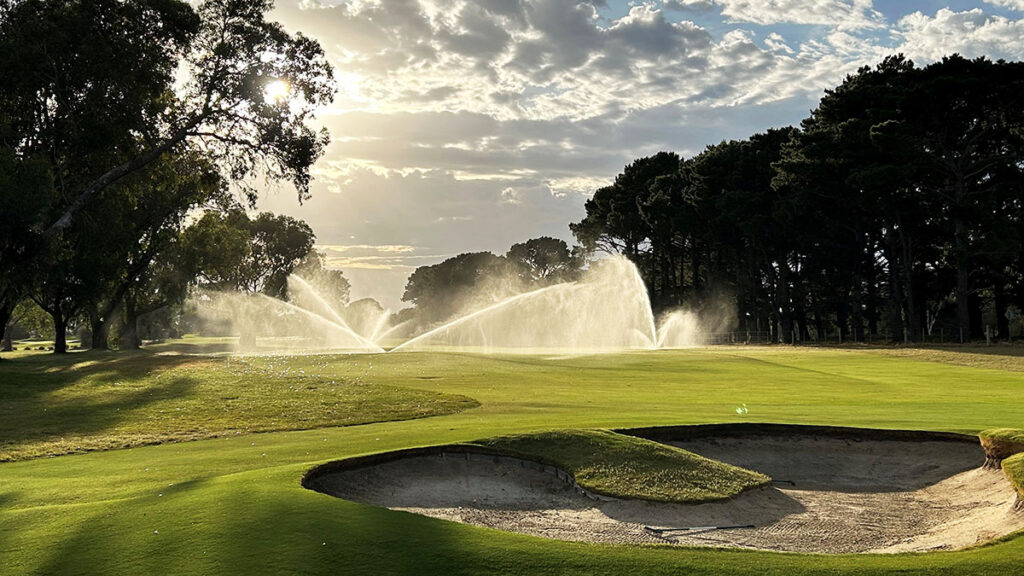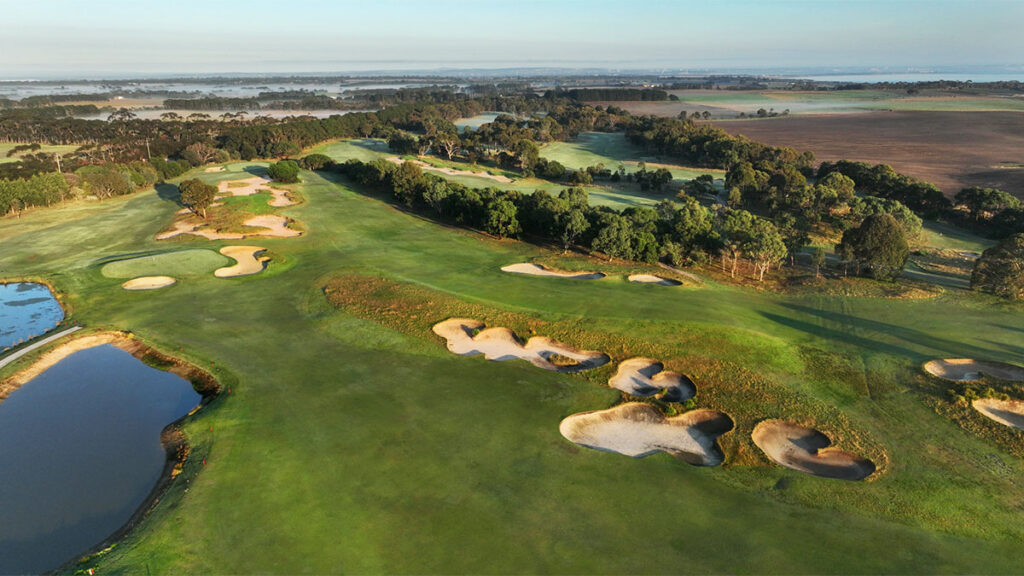More courses plus a growing selection of non-golf attractions have made the Bellarine Peninsula a destination with substance.
Victoria’s beautiful and blossoming Bellarine Peninsula has never lacked top-quality golf courses – now more than ever – yet it’s seemingly short on a much more intangible trait: awareness.
Perhaps it’s because the region has sat in the shadow of the neighbouring Mornington Peninsula, which accelerated at a faster speed on the golf front. Maybe golfers simply bypass the bulbous peninsula on their way through Geelong and down the coast, or possibly they opt to travel elsewhere to play. Whatever the reason, any notion of the Bellarine being a ‘hidden gem’ is puzzling, for it surely ranks among the top handful of golf destinations in the country… if you know about it.
As one golfer from the area explained to me during my most recent visit in late February, if asked about the Bellarine, most Australian golfers know about the timeless and charming Barwon Heads Golf Club, while almost everyone is at least aware of 13th Beach Golf Links due to the club hosting the Vic Open for more than a decade. Beyond those two, some might have heard of Lonsdale Links and possibly Curlewis, while a course like Portarlington would be just a dot on a map to most and not nearly enough golfers know about Queenscliff Golf Club, which occupies Australian Defence Force land on a stunning piece of Swan Island.
“It’s a sleeper [region], that’s for sure,” Marc Leishman, who hails from Warrnambool, just a few hours’ drive down the coast, tells Australian Golf Digest. “You’ve got Lonsdale, Queenscliff, 13th Beach – and Barwon Heads is one of the best courses going around. They’re not that far from Geelong. It’s a good spot. I used to love going down there.”
As exposure to the Bellarine increases, so rises the affection golfers feel for the area. When polled for courses they consider to be “underrated” ahead of our next Top 100 Courses ranking in the May issue, a considerable number of our judging panel mentioned Queenscliff, and a few more angled for nearby Anglesea. Word is slowly getting out.
Word will get out a little more this autumn with the first staging of ‘The Epic’, a week of golf staged across the peninsula from May 5-9. Played over three courses – this year Lonsdale Links, the Beach course at 13th Beach and Queenscliff – the clubs not hosting golf will remain involved by accommodating the welcome and presentation dinners (Curlewis and Portarlington). The concept came about thanks to a new collaboration between six clubs in the area called Golf The Bellarine.
“The six clubs have the intention of using golf not only to promote themselves, but more broadly the Bellarine Peninsula as a tourism destination,” says Mark Hayes, president of Golf The Bellarine. “We’ll engage with our other tourism operators, and our wineries and distilleries, and restaurants and accommodation houses. Hopefully we can really create a segment of the market that has been not available to this area because of the way it was previously structured.”
As for The Epic, “it represents not only a great chance to play tournament golf, but also to get on courses that you may not otherwise find yourself on and that you’ve seen on television,” Hayes says.
A DRAMATIC MAKEOVER
Part of the recent fascination with the Bellarine Peninsula can be attributed to the ambitious yet impressive overhaul of the course now known as Lonsdale Links. When the design firm of Ogilvy Cocking Mead (OCM) embarked on the redesign of the old Lonsdale Golf Club, they took a gamble that paid off. The course today represents a complete transformation from the previous incarnation. The prior version was a neat and tidy layout in a nice location but with few truly remarkable design traits. In renovating the course, OCM decided to adapt some of the most revered architectural features from elsewhere in the world of golf and congregate them on the Bellarine. The result was like uncovering a buried treasure.
The revamped layout is effectively the newest of the area’s courses and ranks among its best. It’s also a course unlike anything you’re likely to have played recently. How’s this for different: a par-70 layout measuring a mere 5,505 metres from the back tees, square edges to many greens, tiny flags for tee markers and one hole where it’s possible to putt a ball out-of-bounds.
If you happen to be a scholar of golf-course architecture, many of the design traits scattered across the 18 holes will be familiar. When OCM began its redesign, they saw an opportunity to incorporate some of revered architect C.B. Macdonald’s ‘template’ designs into the new-look Lonsdale. As such, there’s an homage to several holes and features from famous courses in the northern hemisphere. There’s a reverse version of the famous Redan hole at North Berwick in Scotland, a take on the Alps hole at the National Golf Links of America, plus Biarritz and Punchbowl greens.
The best take is the 16th hole, where the green complex is based on the famous Road hole on the Old Course at St Andrews. There’s a deep, small, but magnetic bunker yawning at you from the centre of the green’s frontage. The green wraps around it, offering distinct sections, while instead of a road there’s a wooden fence barely a pace off the left edge of the green and out-of-bounds beyond it. It’s a driveable par 4 that often plays downwind, but danger lurks right around the target. It’s a magnificent take on arguably the most famous hole in golf.
Homage is a welcome trend in golf-course architecture. Template holes are not rip-offs, because you can never truly recreate the ground or conditions of the original. At Lonsdale, OCM took tried-and-tested concepts and paid tribute to them, using their own interpretations. The results are excellent. With different pin positions and a site peppered by varying winds, it’s a golf course that wears subtly different attire each day.

One of the most enduring characteristics of Barwon Heads Golf Club is how it feels like a place where time has stood still. It’s an old-school layout where the vagaries of links golf come to the fore, while inside the clubhouse is an unmistakable charm, one that asks for a jacket to be worn by men in the dining room. However, don’t mistake these traits for a lack of progress. As those golfers who love the course and club are about to find out, there are changes afoot at Barwon Heads.
From June, the club will embark upon an extensive renovation of the clubhouse and accommodation, with the existing clubhouse expected to close for about a year. That’s bad news – for a little while – if you like staying on-site, but good news in other ways. As preferred tee-times are usually given to house guests, their absence will open more times for non-members. While green-fee players are welcome at certain times of most days anyway, no house guests mean some prime tee-times will now be on offer.
“Some of these tee-times will be offered to green-fee players, giving them a wonderful opportunity to play the course – even on weekends and during other peak times,” says Adam Palmer, Barwon Heads’ marketing and communications manager.
The clubhouse renovation comes hot on the heels of a period in which the golf course was refreshed. The Crafter + Mogford Golf Strategies course architecture firm renovated all 18 greens, while more recently the smart removal of peripheral vegetation in key areas has enhanced the back nine especially.
Barwon Heads is a delight to play. Golfers get the chance to embrace the ground game on the firm, tight surfaces and experience the joy of correctly flighting a shot through the oceanside wind. Little quirks abound, which add to the experience. Driving from the seventh tee, for instance, you fire the ball across a public road in a moment that can, quite literally, stop traffic. Yet the layout’s best attribute might be its playability for all golfers, something noted by Geelong-raised PGA Tour of Australasia professional Deyen Lawson.
“I’ve played there heaps and heaps,” Lawson says. “I think the best part about Barwon is how 180 metres out on the right side of nearly every tee shot – where the old bloke or the average punter with a slice hits it – it’s wide. Then the more you take on, if you hit it 270 or whatever, it narrows in. There’s no point putting a bunker 180 metres out on the right side of the fairway because it’s only going to punish the average golfer. Whereas there, it doesn’t. I’ve played there with all sorts of golfers and it’s a really good track for any level.”

Give credit to 13th Beach Golf Links, which adjoins the Barwon Heads course. More than just hosting one of Australia’s most popular professional tournaments for the past 11 years, the now 45-hole course is proof of what a second coming golf can be for the right parcel of land. What was formerly an asparagus farm was transformed firstly into 18 holes in 2001 with the Beach course, soon after into 36 holes when the Creek course opened in 2004 and now includes a nine-hole par-3 course, which is threaded between a residential estate.
If you’ve never been to 13th Beach before yet feel like you know it intimately, you can thank the Vic Open, which these days is synonymous with the club. Since 2013, the fixture on the PGA and WPGA tours of Australasia has called 13th Beach home, with crowds flocking to the course each February.
While the Beach course ranks higher and occupies the more dramatic landscape, the Creek has generated a solid point of difference architecturally and has a strong following. Member play across the two main courses is almost even, which is always a good barometer for quality. Meanwhile, the short course is ideal for beginner and family play, as well as being a practice haven.
The two main courses have benefited from several recent design tweaks by course-architecture-critic-turned-course-architect, Darius Oliver. Bunker rationalisation was a key focus, with the total across the two courses down from 265 bunkers to nearer to 200 today, with others under the microscope. The program is not an attempt to soften the challenge, rather an appraisal of the role each bunker plays and to which level of golfer it tests. The results are being noticed, even by players at the Vic Open.
“It was a very successful and satisfying tournament,” course superintendent Steven Hewitt told ‘The Cut’, the weekly newsletter of the Australian Sports Turf Managers Association. “One of the pleasing aspects was that many of the golfers noticed and were complimentary of the course improvements that we have been doing over the past three winters. Darius Oliver… is guiding us through a program to rationalise our bunkers and make relevant changes to each hole. We have two more years remaining of this program and to receive compliments on the finished product and the design improvements is rewarding for all.”

Only two golf courses in Australia occupy their own island, and Queenscliff Golf Club is one of them (Nambucca Heads Island Golf Club in coastal New South Wales is the other). The difference at Queenscliff is the heavy-duty security of the neighbouring outfit. You will be checked by Australian Defence Force security at the entrance – one piece of advice: don’t show up without photo ID, as the defence personnel at the gate might not let you in – but thereafter the formalities end. What then begins is a golf excursion that more and more players are discovering is worth the journey to the south-eastern extremity of the peninsula.
Swan Island is wrapped by Swan Bay, which sits right near the tiny gap in Port Phillip Bay between the Bellarine and Mornington peninsulas and Bass Strait beyond. As such, the location yields a windswept layout while some of the landforms and features echo the Sandbelt. Several holes neighbour one another while others allow for complete solitude, like at the third. Many of Queenscliff’s greens and tees are set flush against the edge of the water, best emphasised by the 161-metre par 3 where you could fall into the wetlands from the new back tee, such is the proximity. It’s a secluded and beautiful short hole where intimidation is everywhere. Later, the sixth hole is a gem. Set flush against the bay, it presents a blind drive but one that offers a little help with a bowl-shaped section of the fairway. Usually played into the wind, the water is your companion on the left for all 387 metres.
The course lacks complete irrigation – the fairways can appear thirsty in a dry summer – but the tees, greens and green surrounds are all thriving under the watch of course superintendent Jake Sizer. And being entirely sand-based, it’s a haven for golfers during periods of heavy rainfall. Golfers from other courses often come calling after a stretch of wet weather when their home tracks are unplayable.
Much like the Bellarine Peninsula itself, Queenscliff is slowly earning a reputation for being a must-play layout. It might be vulnerable to any wind that happens to be blowing, but it is an exceptionally fun course to play in a moderate breeze or less.

Portarlington Golf Club calls itself “one of Bellarine golf’s best-kept secrets”, but it shouldn’t be. It’s a little slice of the Sandbelt on the opposite side of the bay. Several bunkers would look right at home at Kingston Heath, while the small greens and occasional stands of imposing pine trees are reminiscent of the top Melbourne courses.
The design is solid, but the condition of the couch-grass fairways is the showstopper. Portarlington’s fairways rank among the best to be found at a regional Australian public course.
“Every time I’ve been to Portarlington, if you were a member of a club and played off 18, the condition is unbelievable and it’s so user-friendly,” Deyen Lawson says. “You could be a beginner or a golf professional and really enjoy it there. I like that it’s not too demanding off the tee. And then every time I’ve played there, the condition of it… you can’t really fault the fairways or anything.”
The run home from the 12th hole is strong. The 13th is a 241-metre par 4 that is so tempting it almost forces you into hitting driver from the tee, with the two strongest par 4s on the course following it. The 18th is a deceptive, 318-metre downhiller where squeezing a drive between the left treeline and a small pond fronting the green is hard to do.

Travelling back towards Geelong, Curlewis Golf Club has demonstrated more progressive moves than almost any Australian golf club in recent years. Once a so-so layout with high potential that sat largely unrealised, it morphed into a complete golf destination. Not only did the club renovate the golf course under the architectural direction of Mike Clayton, but it also expanded the total offering by rebuilding the clubhouse to include a spike bar and restaurant, added modern accommodation for up to 126 people – situated snugly between the first tee and 18th green – and unveiled a tech-led driving range plus mini-golf. It is now destination for much more than just playing 18 holes.
If you haven’t been to Curlewis in a while, the club flipped its two nines in early 2022, while the only cost to the golf course was the need to redesign the closing hole, which Clayton turned into a short par 4 with an amphitheatre green. That allowed space for the accommodation to be built, which now frames the backdrop of the green and greenside bunkering.
There are Sandbelt-esque qualities throughout the layout, which has a bushland setting and substantial undulations on the back nine in particular. Many post-round discussions centre on the magnificently simple but exquisite 12th hole. The 302-metre par 4 plays from a high tee and along a fairway with a pronounced ridge running the length of it. Miss the spine right and fairway bunkers await. Err too far left and you risk driving out-of-bounds. The hole meanders towards a welcoming target, which can lure big hitters into trying to knock one straight onto the green. Mark a 4 on your scorecard there and you’ve distinguished yourself.

Geelong is a sports-mad city, yet oddly there is a dearth of 18-hole courses within its reaches. Geelong Golf Club used to be 18 but was reduced to nine holes in recent years as an eventful tale played out. Founded in 1892, the Geelong club operated as an 18-holer through until the early stages of this century when financial troubles forced a rethink. Ownership and management as well as future ideas for the club changed, as a reduction to nine holes to allow for the inclusion of a residential estate was proposed. The course closed for several years during the redevelopment of what is now a blended space between golf and the Geelong Golf Club Residential Estate. Several of the nine holes designed by course architect Graham Papworth weave between back fences and yards.
It’s a club with a deep but also chequered history yet one that’s forging a new identity. The City of Geelong Bowls Club sits next door, while a gym adjoins the carpark, giving the place a sporting-hub feel. “It’s been a privilege to tell the story of the old and the new,” says PGA professional Paul Christie.
Papworth did a classy job intermingling golf with the residential estate. While a touch claustrophobic for golf in places, there’s also a stadium-like feel to some holes, especially the par-3 fifth, which is ringed by homes.
When it re-opened, the club fought a stigma of being inaccessible. It was formerly private, but is now very much open to the public. And the $21 green fees and speed of play are welcome for golfers seeking value and quick rounds. It’s not unusual for golfers to play the nine holes in 90 minutes. Christie says plenty of golfers will tee off at 7 o’clock and be at work by 8:30am. However, for those wanting the full 18-hole experience, there’s a variety of tee options and even the par of some holes changes when playing more than nine.
The course is a familiar Papworth design. His green sites with runoffs on most greens are familiar, as is his bunkering. Perhaps most ingenious on a site where the boundaries are close is his use of ‘safe zones’. The signage on each hole gives players much more detail than at most courses, even outlining where the broadest – and safest – part of the fairway is with accompanying distances. Players are free to whale away with the driver, but they’ll do so armed with more information about the alternative options than usual.
Which is a little like the region itself. Australian golfers know more about the Bellarine Peninsula with each mention, each Vic Open and each new course to emerge, but you don’t truly know it until you go and experience the area for yourself.
Coastal style
A local’s guide to the Bellarine Peninsula
Australian tour pro Deyen Lawson grew up in Geelong and of those golfers currently plying their trade at home and abroad, few know the region better. Even from afar, he sees the growing reputation the Bellarine Peninsula is carving for itself, both among golfers and more broadly.
“I think it’s got its own identity, but I might be a bit biased,” Lawson says. “I really enjoyed playing pennant in Geelong when I grew up playing all the different golf courses. Now when I go back there, I have a better appreciation of some of the best holes, having now played all around the world and understanding what a good golf hole is. At Queenscliff, two or three holes out the back are world-class golf holes that would look at home in a PGA Tour event. And a course like Barwon Heads seems a lot more private than it really is, and anyone that’s played there is like, ‘Wow, how good is this golf course?’”
Lawson is also well-versed in the area’s non-golf attractions. “Obviously the coastline is very nice, like Torquay and down the Great Ocean Road,” he says. “Ocean Grove and Barwon Heads are lovely, nice little towns to go to.
“If you went on a golf trip, go down and play 13th Beach, Barwon Heads, Lonsdale, Curlewis and the rest, they’ve got some nice wineries as well. The owners of the golf club [at Curlewis] own a few wineries that are really lovely. Jack Rabbit, Flying Brick Cider and Leura Park are all nice. In town are several really nice restaurants. Parkers Steakhouse does the best steaks in Geelong.
“It’s a massive sporting town. Obviously the footy – and when they get a Big Bash game – but the AFL’s massive in Geelong. The Rip Curl Pro is a place to be and the Vic Open is clearly a great sporting event. There’s plenty to do.”

Fairy dust
A worthy diversion down the coast from the Bellarine
No golfer has surely ever made the journey to Port Fairy Golf Links and walked away disappointed with the voyage there or unimpressed by what they found upon arrival. A top-class double or treble act when played before or after the Bellarine Peninsula courses plus the nearby Warrnambool layout, Port Fairy is an ornament to the best aspects of playing golf along a volatile coastline.
A throwback course in so many ways, Port Fairy challenges golfers through its exposed location along Victoria’s south-west coastline where the wind can blow off your cap, and via a short but enchanting seaside layout. Short by modern standards, the 5,887-metre course punches far harder than its scorecard indicates, blowing many an unsuspecting golfer offline if they cannot manage their game in strong winds.
The course built its reputation slowly. While the club began in 1899, the location of the course goes back to only 1962 and even then it was just nine holes. More were added during the 1970s before finally reaching 18 holes in 1985 under the architectural watch of Kevin Hartley. The remote location meant not enough knowledgeable golfers saw Port Fairy at first, particularly in the time before the current ‘build it and they will come’ era of destination golf. It took until 2002 before the course cracked our biennial Top 100 Courses ranking and until 2020 to rank higher than 60th. Even at No.55 today (keeping in mind our 2024 ranking will be published next month), it remains underrated in the eyes of many.
Marc Leishman calls Warrnambool home, but with Port Fairy just a 20-minute drive away, the LIV Golf star is still familiar with the layout. “My favourite holes there are probably 12, 13, 14 – a par 5 along the water, short par 4 then a long par 4,” Leishman says. “Really fun golf course… and good people to go along with it.”



